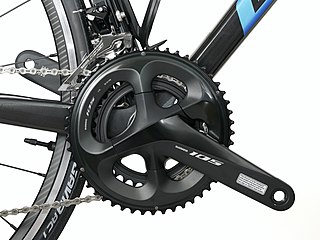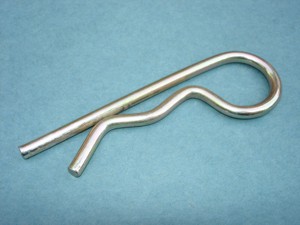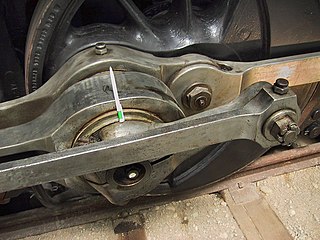
The crankset or chainset is the component of a bicycle drivetrain that converts the reciprocating motion of the rider's legs into rotational motion used to drive the chain or belt, which in turn drives the rear wheel. It consists of one or more sprockets, also called chainrings or chainwheels attached to the cranks, arms, or crankarms to which the pedals attach. It is connected to the rider by the pedals, to the bicycle frame by the bottom bracket, and to the rear sprocket, cassette or freewheel via the chain.

The bottom bracket on a bicycle connects the crankset (chainset) to the bicycle and allows the crankset to rotate freely. It contains a spindle to which the crankset attaches, and the bearings that allow the spindle and crankset to rotate. The chainrings and pedals attach to the cranks. Bottom bracket bearings fit inside the bottom bracket shell, which connects the seat tube, down tube and chain stays as part of the bicycle frame.

A fastener or fastening is a hardware device that mechanically joins or affixes two or more objects together. In general, fasteners are used to create non-permanent joints; that is, joints that can be removed or dismantled without damaging the joining components. Steel fasteners are usually made of stainless steel, carbon steel, or alloy steel.

A clevis fastener is a two-piece fastener system consisting of a clevis and a clevis pin head. The clevis is a U-shaped piece that has holes at the end of the prongs to accept the clevis pin. The clevis pin is similar to a bolt, but is either partially threaded or unthreaded with a cross-hole for a split pin. A tang is a piece that is sometimes fitted in the space within the clevis and is held in place by the clevis pin. The combination of a simple clevis fitted with a pin is commonly called a shackle, although a clevis and pin is only one of the many forms a shackle may take.

A linchpin, also spelled linch pin, lynchpin, or lynch pin, is a fastener used to prevent a wheel or other part from sliding off the axle upon which it is riding. The word is first attested in the late fourteenth century and derives from Middle English elements meaning "axletree pin".

A screw thread, is a helical structure used to convert between rotational and linear movement or force. A screw thread is a ridge wrapped around a cylinder or cone in the form of a helix, with the former being called a straight thread and the latter called a tapered thread. A screw thread is the essential feature of the screw as a simple machine and also as a threaded fastener.

A split pin, also known in the US as a cotter pin or cotter key, is a metal fastener with two tines that are bent during installation, similar to a staple or rivet. Typically made of thick wire with a half-circular cross section, split pins come in multiple sizes and types.
A wedge is a triangular shaped tool, a portable inclined plane, and one of the six simple machines. It can be used to separate two objects or portions of an object, lift up an object, or hold an object in place. It functions by converting a force applied to its blunt end into forces perpendicular (normal) to its inclined surfaces. The mechanical advantage of a wedge is given by the ratio of the length of its slope to its width. Although a short wedge with a wide angle may do a job faster, it requires more force than a long wedge with a narrow angle.

A castellated nut, sometimes referred to as a castle nut, is a nut with slots (notches) cut into one end. The name comes from the nut's resemblance to the crenellated parapet of a medieval castle. Castellated nuts are sometimes referred to incorrectly as castigated nuts.

A taper pin is a fastener used in mechanical engineering. They are steel rods with one end having a slightly larger diameter than the other.

A punch is a tool used to indent or create a hole through a hard surface. They usually consist of a hard metal rod with a narrow tip at one end and a broad flat "butt" at the other. When used, the narrower end is pointed against a target surface and the broad end is then struck with a hammer or mallet, causing the blunt force of the blow to be transmitted down the rod body and focused more sharply onto a small area. Typically, woodworkers use a ball-peen hammer to strike a punch.

A Hirth joint or Hirth coupling is a type of mechanical connection named after its developer Albert Hirth. It is used to connect two pieces of a shaft together and is characterized by tapered teeth that mesh together on the end faces of each half shaft.

A screw is an externally helical threaded fastener capable of being tightened or released by a twisting force (torque) to the head. The most common uses of screws are to hold objects together and there are many forms for a variety of materials. Screws might be inserted into holes in assembled parts or a screw may form its own thread.

A nut is a type of fastener with a threaded hole. Nuts are almost always used in conjunction with a mating bolt to fasten multiple parts together. The two partners are kept together by a combination of their threads' friction, a slight stretching of the bolt, and compression of the parts to be held together.

An R-clip, also known as an R-pin, R-key, hairpin cotter pin, hairpin cotter, bridge pin, hitch pin clip or spring cotter pin, is a fastener made of a durable but flexible material, commonly hardened metal wire, resembling the shape of the letter "R".

Machine element or hardware refers to an elementary component of a machine. These elements consist of three basic types:
- structural components such as frame members, bearings, axles, splines, fasteners, seals, and lubricants,
- mechanisms that control movement in various ways such as gear trains, belt or chain drives, linkages, cam and follower systems, including brakes and clutches, and
- control components such as buttons, switches, indicators, sensors, actuators and computer controllers.

A bolt is an externally helical threaded fastener capable of being tightened or released by a twisting force (torque) to a matching nut. The bolt has an external male thread requiring a matching nut with a pre-formed female thread.

A mechanical joint is a section of a machine which is used to connect one or more mechanical part to another. Mechanical joints may be temporary or permanent; most types are designed to be disassembled. Most mechanical joints are designed to allow relative movement of these mechanical parts of the machine in one degree of freedom, and restrict movement in one or more others.


















